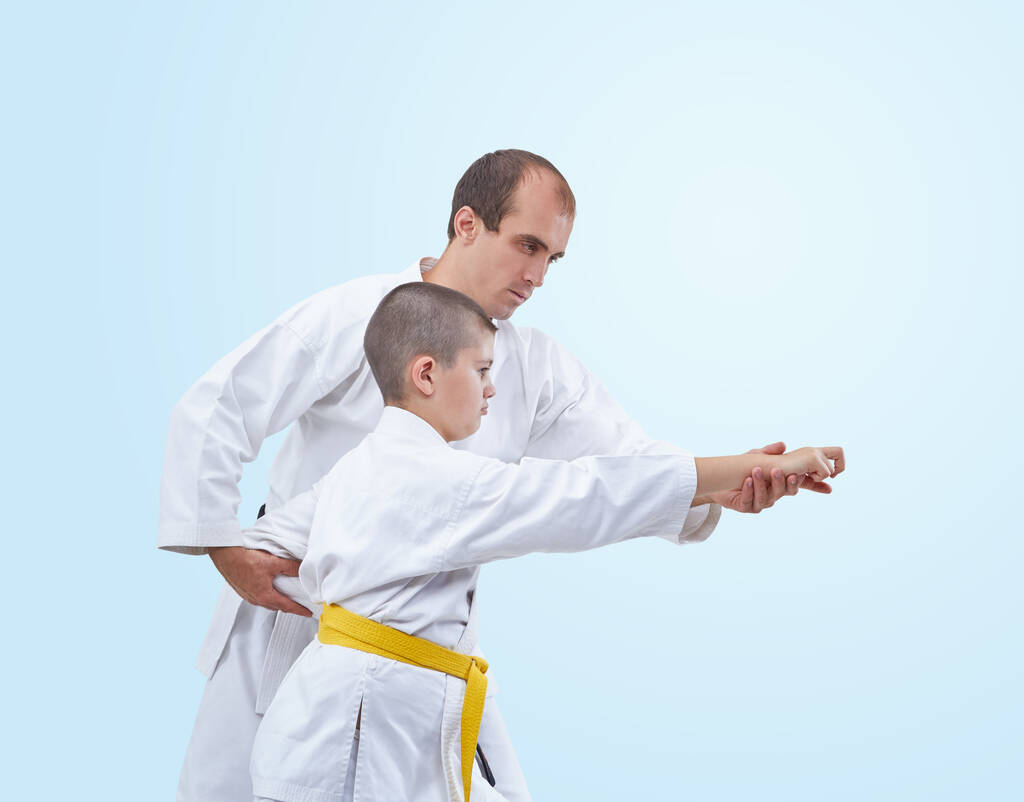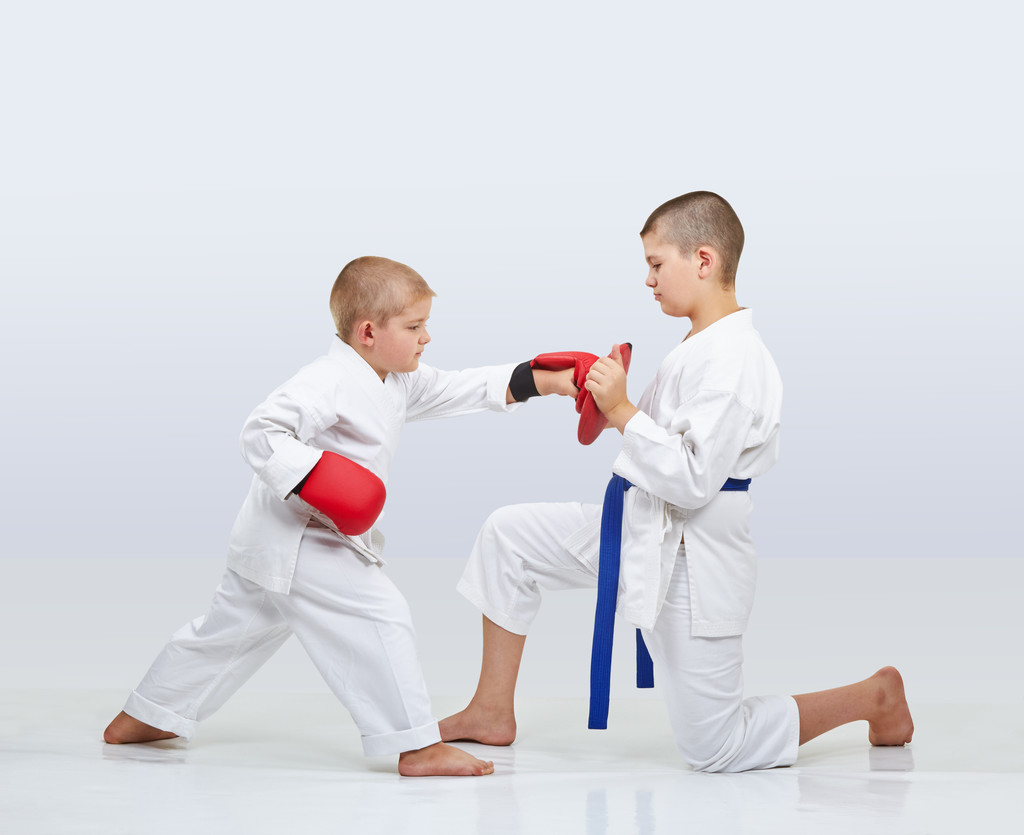Discover how to effectively teach self-defense techniques to 5-6 year old children with this comprehensive step-by-step guide.
Teaching Self-Defense to 5-6 Year Old Children: A Step-by-Step Guide
Teaching self-defense to young children may seem like a daunting task, but with the right approach and a touch of playfulness, it can be an empowering and exciting experience for both you and your child. In this step-by-step guide, we will explore the importance of self-defense for young children and provide you with practical tips and techniques to help your 5-6 year old develop essential skills to stay safe in different situations.

Understanding the Importance of Self-Defense for Young Children
The safety and well-being of our children are always at the forefront of our minds. Introducing self-defense at an early age not only equips children with the necessary tools to protect themselves but also fosters a sense of confidence and independence. Self-defense training is not about encouraging violence, but rather about teaching children how to navigate potentially dangerous situations and effectively assert themselves when necessary.
When it comes to child safety, self-defense plays a vital role. It empowers kids to recognize potential threats and respond appropriately. By teaching your child self-defense, you are providing them with an extra layer of protection and the knowledge to make informed decisions in challenging situations. It’s important to emphasize that self-defense is about prevention, awareness, and having a safety plan, rather than resorting to physical confrontation as a first line of defense.
Building confidence and self-esteem is another significant benefit of self-defense training for children. When kids learn and master new skills, it instills a sense of accomplishment and boosts their self-image. As they grow more confident in their abilities, children become better equipped to handle life’s challenges with resilience and determination.
The Role of Self-Defense in Child Safety
Self-defense is not just about learning a few moves to protect oneself physically. It goes beyond that. Self-defense training teaches children to be aware of their surroundings, to identify potential threats, and to assess the best course of action. By developing these skills, children can avoid dangerous situations altogether, effectively preventing harm.
Moreover, self-defense training emphasizes the importance of communication and assertiveness. Children learn how to use their voice and body language to set boundaries, express their discomfort, and seek help when needed. These skills are invaluable in situations where physical confrontation can be avoided through effective communication.
Self-defense also teaches children the importance of self-control and discipline. They learn to manage their emotions and make rational decisions even in high-pressure situations. This ability to stay calm and focused can be crucial in diffusing potentially volatile situations and ensuring personal safety.
Building Confidence and Self-Esteem through Self-Defense
Self-defense training provides children with a platform to challenge themselves, set goals, and achieve them. As they progress in their training, they experience a sense of accomplishment and pride in their abilities. This positive reinforcement helps build their confidence and self-esteem.
Additionally, self-defense training teaches children to trust their instincts and believe in their own capabilities. They learn that they have the power to protect themselves and make a difference. This newfound confidence extends beyond the training environment and positively impacts various aspects of their lives, such as academics, sports, and social interactions.
Furthermore, self-defense training promotes a healthy body image and physical fitness. Children learn the importance of taking care of their bodies through regular exercise and proper nutrition. This holistic approach to self-defense not only enhances their physical well-being but also contributes to their overall self-esteem.
Preparing Your Child for Self-Defense Training
Before diving into the world of self-defense, it is essential to ensure that your child is physically and mentally ready for the training. Here are some steps you can take to prepare your child for self-defense training:
Assessing Your Child’s Physical Abilities
Every child develops at their own pace, and it’s crucial to assess your child’s physical abilities before starting self-defense training. Understanding their strength, coordination, and flexibility will help you tailor the techniques and exercises to their specific needs. It is important to remember that self-defense training is not about making your child invincible, but rather equipping them with the skills and confidence to protect themselves in potentially dangerous situations.
When assessing your child’s physical abilities, consider their overall fitness level. Are they active and engaged in physical activities such as sports or dance? Regular exercise can contribute to their physical preparedness for self-defense training. Additionally, observe their coordination and balance. These skills are essential for executing self-defense techniques effectively.
Flexibility is another crucial aspect to consider. Stretching exercises can help improve your child’s flexibility, which is important for executing certain self-defense moves. Encourage your child to engage in activities that promote flexibility, such as yoga or gymnastics.
If you have any concerns about your child’s physical abilities, consulting with a pediatrician or a qualified self-defense instructor can provide valuable insights. They can assess your child’s readiness and recommend any modifications or adjustments to the training program.
Introducing the Concept of Self-Defense to Your Child
Before jumping into the physical aspects of self-defense, start by having an open conversation with your child about personal safety. It is important to create a safe and supportive environment for this discussion. Encourage your child to express any fears or concerns they may have and assure them that their feelings are valid.
Discuss scenarios they may encounter and reinforce the importance of assertiveness, boundaries, and seeking help from trusted adults when needed. Teach them about the concept of personal space and the importance of recognizing and respecting the personal space of others. Emphasize the importance of using their voice to assert themselves and set boundaries when they feel uncomfortable or threatened.
By establishing a foundation of awareness and respect, your child will better understand the purpose of self-defense training. They will learn that self-defense is not about aggression or violence but about protecting themselves and others from harm.
It is also essential to educate your child about the legal and ethical aspects of self-defense. Teach them about the concept of proportionate force and the importance of using self-defense techniques only when necessary and as a last resort. Encourage them to seek help from authorities whenever possible and to prioritize their safety above all else.
By taking the time to assess your child’s physical abilities and introducing them to the concept of self-defense, you are setting the stage for a successful and empowering training experience. Remember to support and encourage your child throughout their self-defense journey, and always prioritize their safety and well-being.
Basic Self-Defense Techniques Suitable for 5-6 Year Olds
Now, let’s dive into the fun and engaging part: the basic self-defense techniques suitable for 5-6 year olds. Keep in mind that at this age, children are still developing their motor skills, so it’s essential to focus on simple, easy-to-remember techniques that are age-appropriate and effective. Here are a few key techniques to get started:
Teaching the Right Stance and Movement
A strong foundation starts with the correct stance. Teach your child to stand with their feet shoulder-width apart, knees slightly bent, and arms raised in front for protection. Emphasize the importance of balance and mobility, teaching them to move and pivot swiftly to evade potential threats.
When teaching the right stance and movement, it’s crucial to make it enjoyable for the children. You can create fun games that involve mimicking animal movements or playing “Simon Says” with self-defense actions. By incorporating playfulness into the learning process, children are more likely to retain the techniques and apply them when needed.
Furthermore, it’s important to explain to children why the right stance and movement are essential. You can tell them stories about how animals protect themselves in the wild or use examples from their favorite superheroes. This not only helps them understand the concept better but also sparks their imagination and enthusiasm for self-defense.
Simple Strikes and Blocks for Young Children
Teaching young children basic striking and blocking techniques can be an exciting and empowering experience. Start with simple strikes like open-handed palm strikes or using a soft punching bag, focusing on the concept of hitting and creating distance rather than causing harm.
When introducing striking techniques, it’s beneficial to incorporate storytelling and visualization. Encourage the children to imagine a target, such as an imaginary villain or an object, and practice striking towards it. This not only makes the learning process more enjoyable but also helps children develop their coordination and accuracy.
In addition to strikes, it’s crucial to teach young children basic blocking techniques to help them deflect potential attacks. You can use soft foam paddles or even balloons to simulate incoming strikes, allowing the children to practice their blocking skills in a safe and playful manner.
Remember, repetition is key when teaching self-defense techniques to young children. Encourage them to practice regularly, but always make it a positive and enjoyable experience. By doing so, you are not only equipping them with essential self-defense skills but also instilling confidence and a sense of empowerment that will benefit them throughout their lives.
Making Self-Defense Training Fun and Engaging
Children learn best when they are having fun. Infuse playfulness and creativity into your self-defense training sessions to keep your child engaged and excited. Here are a couple of ideas to incorporate into your training:
Incorporating Games into Self-Defense Training
Turn self-defense training into a game by creating scenarios and challenges that require your child to utilize their newly acquired skills. For example, you can set up an obstacle course where they need to navigate while practicing their stances, strikes, and blocks. By making it fun and interactive, your child will eagerly look forward to each training session.
Motivating Your Child to Practice Regularly
Rewarding your child’s efforts and progress will help them stay motivated and committed to their self-defense training. Create a visual chart or a sticker system to track their achievements. Celebrate milestones and provide small rewards like a special outing or their favorite healthy snack. Positive reinforcement goes a long way in keeping children engaged and motivated.
Safety Measures During Self-Defense Training
While self-defense training aims to empower children, safety should always be a top priority. Here are a few important safety measures to implement during training sessions:

Ensuring Physical Safety During Practice
When engaging in self-defense techniques, it’s crucial to create a safe environment. Choose a spacious area free of objects that could pose a risk of injury. Use cushions or soft mats to provide additional padding and minimize the impact of falls. Create clear boundaries and teach your child to respect personal space during practice.
Teaching the Ethical Use of Self-Defense Skills
Throughout your child’s self-defense training, it’s vital to emphasize the ethical use of these skills. Emphasize that self-defense techniques should only be used in situations where they feel physically in danger or when there is no other option to escape. Teach them the importance of de-escalation strategies, verbal assertiveness, and seeking help from trusted adults as the first line of defense.
Teaching self-defense to 5-6 year old children is a journey that combines safety, confidence-building, and the joy of learning new skills. By following this step-by-step guide and adding your own personal touch, you are empowering your child to navigate the world with confidence and ensuring their safety in an ever-changing environment. Remember, the key is to make the learning process fun, engaging, and age-appropriate to create a foundation of empowerment that will last a lifetime.



